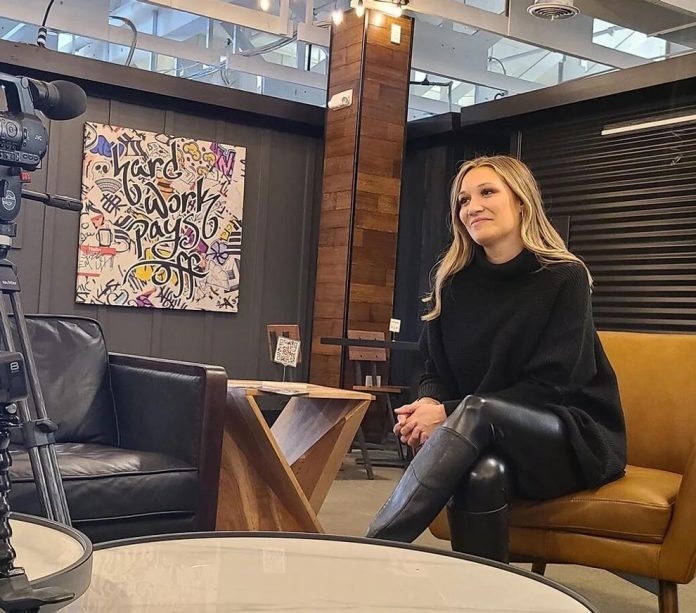By Alexa Shrake, TheStatehouseFile.com.
For the past several years, journalists have been labeled the “enemy” by political figures like former president Donald Trump. When the insurrection in the nation’s capitol happened on Jan. 6, 2021, “Kill the Media” was written on a door in the building.
Many within the field have discovered those wounds to be ever-present. It’s become so commonplace that the Franklin College Pulliam School of Journalism partnered with the Trust for Trauma Journalism to hold the first Trauma Journalism Symposium this past fall.
Clocking InÂ
Depending on the beat, reporters clock in at the beginning of a shift ready to face the day. They may be sent out on a homicide or to a football game on a Friday night. Every day looks different, and for many, that’s what they love about the job.
The crimes reporter for The Daily Journal in Franklin, Noah Crenshaw, covered the Greenwood Park Mall shooting for several days and said he hasn’t been to the food court area where the shooting occurred since.
“I still do not want to go near the food court,†Crenshaw said. “It’s just knowing that something bad happened there just kinda makes a trip to the mall not as fun. I don’t want to invite that energy in.â€
Crenshaw said since covering things like mass shootings he has become more cautious and has the plan to get out in case of an emergency.
He said he is good at compartmentalizing and using video games as a way to de-stress.
“It was kind of difficult, but I felt like I had to keep helping with the coverage and keep going because everyone wanted to know what was going on,†Crenshaw said.
“That’s what we’re here for. We’re here for covering all the rezonings and housing development, but when there’s a crisis type of situation like that, people tend to turn to us the most. It felt like probably some of the most important work we’ve done.â€
Tim Evans, the investigative editor at The Indianapolis Star, had covered child abuse crimes for most of his career before working on the national story about USA Gymnastics doctor Larry Nassar.
“I had been covering child abuse for years, and I kind of just learned to compartmentalize it,†Evans said. “I know one of those cases I wrote about around 2006, 5 or 6 years old, a little boy was born the same day as my son. So it’s like, holy cow, if he’d gone home with a different family from the hospital, what would his life have been like.â€
More recently, Evans was the editor for the Star’s jails investigation.
“That’s probably the most horrific thing I’ve ever seen,†Evans said. “However many years it’s been— 50 years almost.â€
He watched surveillance footage of a young man slowly dying from being tased and stepped on for pain compliance when he was suffering from withdrawal.
“I would write maybe a feature story or just something that I call sometimes palate cleansers, just to kind of change the pace to write something,†Evans said. “I like history and oddball stuff. I think I wrote a story about people who go out and wade in creeks and reach under logs to try to get snapping turtles during the middle of the jail stuff, just for something different to do and to see a different side of the world.â€
Putting In The PrepÂ
Reporters are sometimes the first to arrive at a scene before police and fire.
“Not every journalist will be affected in the same way,†said the director of journalism for WITF News, Scott Blanchard. “And that’s OK, it’s fine whether you are or aren’t. And I think it’s because we’re different people, right, and we respond differently to different things.â€
Blanchard helped start a peer-to-peer program at his previous newsroom in New York after talking to some reporters about how they approach sources with trauma and deal with their trauma.
He only got one complaint about the program being a “psychological program.†Other than that, it was well received and helped the reporters feel better equipped to talk with sources after a traumatic event and check in on each other.
“A photographer from one of our sister papers who had been through our training called our photographer to say, ‘Hey, I’m just checking in on you, you know, because that must have been crazy to cover, you know, how are you doing?’ Our photographer was like, ‘Oh, are you here supporting me?’ So it was those kinds of things. It was evident that we had been able to integrate it into our culture in the way we worked there,†Blanchard said.
Mark Massé, author of “Trauma Journalism: On Deadline,†said he noticed trends after speaking with several reporters at different newsrooms.
“It’s a myth that the journalist is somehow this Marvel superhero who has no feelings because if you show your feelings, you’re not a good journalist,†Massé said. “Journalists are not Marvel heroes. Many of them are incredibly psychologically strong.â€
Fear and newsroom culture were words spoken by many of the people he talked to.
“It has to do with the culture, and that word kept coming up and up and up and up—newsroom culture,†Massé said. “Is it old school? Where you have somebody who just says, ‘I don’t want to hear about it, toughen up, suck it up, go out and do it.’â€
While the culture in some newsrooms may shift, the sense of going out and doing it is still there.
Massé said when doing research for his book, he found that firefighters and soldiers have mandatory briefings after possibly traumatic events. But reporters don’t.
“Then hopefully there’s empathetic editors, directors, newsroom directors, and fellow reporters or fellow staff,†Massé said.
ResourcesÂ
The Dart Center for Journalism & Trauma has resources for reporters and editors to be aware and prepared when talking to sources with trauma and handling how it affects them.
The International Journalist Network says to factor in recovery time in their list of ways to de-stress after a shift.
Dr. Frank Ochberg, who was one of the first people to found psychotraumatology, said he wants “post-traumatic stress disorder” to be renamed “post-traumatic stress injury” because there is negative cogitation to the word disorder. When it is treated as an injury, it is like an athlete’s injury where they know the hurt and pain with be there but with work and time they can learn to live with it in a healthy manner.
According to the U.S. Department of Veteran Affairs, despite about 25% of journalists getting PTSD, few editors recognize it, and they rarely get counseling.
“These studies highlight that journalism can be a profession bearing some risk of physical harm and long-term emotional distress and that the greater the level of exposure, the greater the risk of distress,†the VA stated in its study of journalists and PTSD.
But the rate of PTSD is still low compared to how often journalists witness traumatic events. The American Psychological Association said that is because journalists tend to be resilient.
“We need to do that better. And we can do that better by learning more about it, by making it part of our culture, you know, by talking to each other about it,†Blanchard said.






Truthfully reporting the news will ease the trauma of the job. Editorializing within the report will increase the negative view the public has of the “news” media.
Point well taken.
I agree with VICTORY.
The number of journalists who continued to failed to tell the truth, instead spread the lies, that Trump got cheated out of the election? Trump got beat. Plain and simple truth. They brought all of that trauma on themselves.
Comments are closed.